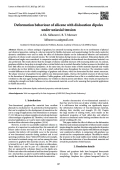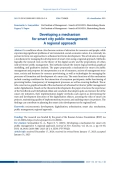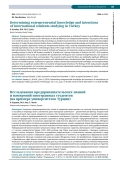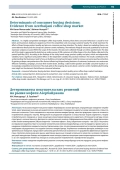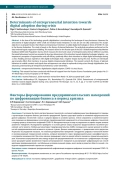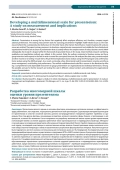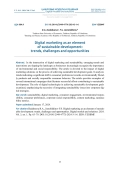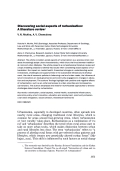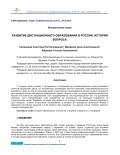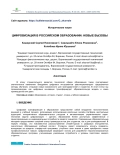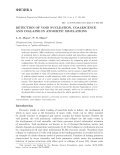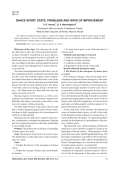Silicene, as a silicon analogue of graphene, has attracted increasing attention due to its combination of physical and chemical properties, making it a relevant material for flexible electronics and nanotechnology. In this study, molecular dynamics simulations were used to study the effect of dislocation dipoles on the deformation behavior and mechanical properties of silicene under uniaxial tension. The wrinkle formation during tension was analyzed. Dislocation dipoles with different arm lengths were considered. A comparative analysis with graphene, the benchmark two-dimensional material, was also performed. The results showed that the strength of silicene smoothly decreases with increasing defect size. In contrast, graphene exhibits a sharp drop in strength when a critical defect size is reached; thereafter, further increases in the defect size have little effect on its mechanical properties. At the same time, the fracture strain of both materials depends only weakly on defects due to their ability to form wrinkles, which redistribute stress throughout the structure. The simulation results revealed differences in the wrinkle morphology of graphene and silicene, which are determined by their atomic structures. The planar structure of graphene forms uniform one-dimensional ripples, whereas the buckled structure of silicene leads to the formation of inhomogeneous wrinklons. Unlike graphene, with transition from a flat to a wrinkled state and from a wrinkled to a flat state again during deformation, the wrinkles in silicene persist until failure. These results are important for studying the strength and defect influence in two-dimensional materials, as well as for assessing their potential applications in flexible electronics.
In conditions when cities become centres of attraction for resources and people, while experiencing significant problems of environmental, social, economic nature, it is extremely important to form new approaches to urbanised territories development. The article aims to design a mechanism for managing the development of smart cities using a regional approach. Methodologically, the research rests on the theory of the digital society and the propositions of urbanised territories’ public management. The methods include the system-logical method, graphical modelling, and qualitative analysis. The paper propounds a mechanism for smart city public management and proposes its interpretation as a set of measures, actions of management structures, society and business for resource provisioning, as well as technologies for managing the processes of formation and development of a smart city. The main functions of this mechanism include creating conditions for the interaction of ecosystem participants, stable functioning of governing bodies, transparency of management processes, as well as ensuring feedback. The article constructs a graphical model of the mechanism of urbanised territories’ public management under digitalisation. Based on the theoretical developments the paper structures the experience of the Sverdlovsk and Chelyabinsk oblast and concludes that despite quite an extensive list of the smart city initiatives, their implementation largely overlooks such aspects as determining the state and development directions of the digitalisation objects, assessing the risks of smart city projects, maintaining quality of implementation processes, and auditing smart city projects. The findings can contribute to planning the smart cities development at the regional level
Entrepreneurial knowledge and intention focus on understanding an individual’s interest in and abilities towards entrepreneurial activities. Another issue is the impact of cultural differences on entrepreneurial intention. The purpose of the study is to reveal the impact of entrepreneurship knowledge on entrepreneurial intention of international students receiving higher education in Turkey. We also examine whether there are differences in entrepreneurial knowledge and entrepreneurial intention according to gender, department, having an entrepreneurial business idea, receiving entrepreneurship education or not and monthly expenditure amount. The methodological basis of the study resides in the concept of entrepreneurial knowledge and planned behaviour theory. Among the research methods are frequency and regression analyses, parametric tests, convenience sampling method. A total of 380 students enrolled in 20 public and 5 private universities in Turkey in the 2021–2022 academic year participated in the survey and completed the questionnaire. Participants were reached through electronic and social media environments or face-to-face communication. The research results reveal that there are statistically significant differences between entrepreneurial knowledge and intention with educational status, entrepreneurial idea, department of study and the amount of monthly expenses. Furthermore, regression analysis showed that entrepreneurial knowledge and entrepreneurship education have a significant positive effect on students’ entrepreneurial intentions. The findings of this study provide valuable guidance for policymakers and curriculum preparers to understand international students’ entrepreneurial intentions and promote entrepreneurial intentions in universities
In a highly competitive Azerbaijani coffee shop market, knowing what drives consumer behaviour is crucial for marketers and businesses looking to separate out from the competition and encourage customer loyalty. The article examines the effects of brand image, product quality and price on consumer purchase intention. The study is based on marketing theory, consumer behavior theory and the concept of customer-centric marketing. The methods of logical-structural, quantitative, factor and regression analysis are used. Within the scope of the research, the data were collected through an online questionnaire. The data set of the study is represented by data from an online survey of 298 customers of coffee shops in the city of Baku, collected in the period April-May 2023. According to the findings of the study, brand image, product quality and price, which are independent variables, have a significant and positive effect on the dependent variable, the purchase intention. The results contribute to the understanding that businesses need to focus on building a strong brand image in order to increase consumer purchase intention. By gaining a deeper comprehension of the factors influencing the purchasing decisions of customers, businesses can create more effective marketing campaigns, increase their market share, develop a solid market position and build consumer loyalty in an increasingly competitive environment. The study adds to the ongoing discussion about customer-centric marketing by throwing new insight on the elements that influence consumer behaviour.
In the time of fast technology growth, digitalization is transforming the landscape of many businesses. However, the antecedents of digital adoption within small and medium-sized enterprises in crisis are yet not fully understood. This study’s objective is to pinpoint factors that influence entrepreneurs’ intentions to utilize digital technologies in times of COVID-19 crisis in the Russian Federation. The study is based on the theory of planned behaviour. The analytical procedures performed on the data involved logistic regression modelling. This research draws on the Russian part of the 2021 Global Entrepreneurship Monitor Database (GEM) Adult Population Survey which measures the level and nature of entrepreneurial activity in different countries. Perceived behavioural control was revealed to be a key determinant of the intention towards digital technologies’ adoption – entrepreneur’s perception of opportunities and self-efficacy positively affects their intention to adopt digital technologies during a crisis. Notably, previous experience with digital technologies had a negative impact during the crisis. Further, an individual’s age inversely affects their tendency to pursue digital entrepreneurial initiatives. The research extends the theory of planned behaviour to volatile contexts and signals how entrepreneurs can adapt to upheavals during crises through digitalization, thus advancing understanding of entrepreneurial behaviour under extremities
Presenteeism is among the key factors that negatively affect employee efficiency and, therefore, company organizational performance. The existing measurement tools for assessing presenteeism highlight health-related issues as the main reason behind this counterproductive behaviour. On the other hand, other factors that influence modern business life and processes are omitted. The paper’s primary purpose is to develop a comprehensive measurement tool suitable for the individual and organizational multi-factor structure of presenteeism that accurately reflects the complex nature of today’s business world. Methodologically, the research is shaped within the framework of grounded theory. In the study, mixed methods research combining qualitative and quantitative methods was utilized. In this context, firstly, the authors conducted a literature review and focus group interviews with experts in the field in order to reveal the conceptual structure. We analysed the data using content analysis and then moved on to writing 18 scale items. We performed exploratory factor analysis using the SPSS program and confirmatory factor analysis using the AMOS program. As a result, we develop a four-dimensional scale for presenteeism covering work focus, stress management, social loafing, and performance. The verified multidimensional scale fills a vacuum in the literature by offering a comprehensive and dependable instrument to gauge presenteeism on organizational and individual dimensions. Among the possible avenues for further research are testing the scale in different cultural contexts and addressing the organizational causes of presenteeism
In the intersection of digital marketing and sustainability, emerging trends and innovations are shaping the landscape as businesses increasingly recognize the importance of environmental and social responsibility. The article is devoted to the impact of digital marketing solutions on the process of achieving sustainable development goals. It analyzes trends indicating a significant shift in consumer preferences towards environmentally friendly products and socially responsible consumer behavior. The article provides examples of several international campaigns that illustrate successful efforts contributing to sustainable development. The role of digital technologies in achieving sustainable development goals examined, emphasizing the necessity of integrating sustainability issues into corporate digital strategies
The article considers social aspects of rurbanization as a process when rural areas increasingly adopt urban characteristics, which blurs the lines between traditional rural and urban lifestyles. The article presents a comprehensive literature review and a topic modeling analysis to identify key issues when considering social aspects of rurbanization: the impact on mental health, theoretical changes in understanding social interactions, challenges and opportunities in the sustainable infrastructure development, the role of economic policies in balancing rural and urban needs, the influence of smart innovations on local governance and community engagement, changes in education and employment. The authors’ findings highlight both positive and negative effects of rurbanization, such as an enhanced access to urban amenities and increased social tensions. The authors emphasize the need for multi-faceted approaches to diverse challenges determined by rurbanization.
Every year the interest in software platforms for online learning among Russian customers continues to grow, which contributes to the activation of local companies specializing in the development of such systems. Recently, domestic manufacturers have started to actively promote their solutions for distance education, but it is premature to say that the market for such products in Russia has already been fully formed. This is confirmed by the fact that Russian companies often position their developments as unique, having no competitors in the domestic market. This situation is caused not so much by the desire to successfully promote their products as by the lack of studies that would analyze and compare Russian solutions in this area in detail. We hope that this article will help to change the current state of affairs.
At a time of rapid technological development, the field of education is also undergoing significant transformation. The introduction of digital tools is revolutionizing traditional teaching methods, opening up new opportunities for teachers and students. In this article, we will analyze how digital innovations are transforming the educational model and what benefits they provide.
Extraction of required information from atomic configurations is crucial for efficient use of molecular dynamics (MD) simulations, and automating this process allows the collection of statistical data to develop and validate physical models and data-driven approaches. Here we update the previously developed pore searching algorithm to automatically detect the events of void nucleation, collapse and coalescence by comparing pairs of atomic configurations. We calculate an intersection matrix, which shows common regions between voids of current and previous time frames, and analysis of this intersection matrix gives a numerical criterion for determination of the considered events. The updated algorithm is verified in the case of small MD system and further used to analyze a large MD system with many hundreds of voids. The predominance of void collapse is confirmed in the case of uniform triaxial tension of solid aluminum, while void coalescence instead of collapse is detected in the case of a more complex loading with axial compression and lateral tension. This dependence of the predominant mechanism on the loading path correlates with previous finite element analysis in the literature. Another interesting finding is a continuing nucleation and collapse of voids far beyond the fracture beginning at a level of negative pressure much lower than the spall strength, which can be attributed to a developed defect structure of material produced by plastic growth of voids.
The authors consider the dance sport as a sport. The history of the development of dance sports and its current state are presented. A review of scientific publications on this topic was conducted on the website of Elibrary. Different directions of sports dances are considered.
